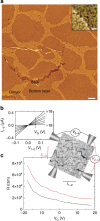High charge mobility in two-dimensional percolative networks of PbSe quantum dots connected by atomic bonds
- PMID: 26400049
- PMCID: PMC4598357
- DOI: 10.1038/ncomms9195
High charge mobility in two-dimensional percolative networks of PbSe quantum dots connected by atomic bonds
Abstract
Two-dimensional networks of quantum dots connected by atomic bonds have an electronic structure that is distinct from that of arrays of quantum dots coupled by ligand molecules. We prepared atomically coherent two-dimensional percolative networks of PbSe quantum dots connected via atomic bonds. Here, we show that photoexcitation leads to generation of free charges that eventually decay via trapping. The charge mobility probed with an AC electric field increases with frequency from 150 ± 15 cm(2) V(-1) s(-1) at 0.2 terahertz to 260 ± 15 cm(2) V(-1) s(-1) at 0.6 terahertz. Gated four-probe measurements yield a DC electron mobility of 13 ± 2 cm(2) V(-1) s(-1). The terahertz mobilities are much higher than for arrays of quantum dots coupled via surface ligands and are similar to the highest DC mobilities reported for PbSe nanowires. The terahertz mobility increases only slightly with temperature in the range of 15-290 K. The extent of straight segments in the two-dimensional percolative networks limits the mobility, rather than charge scattering by phonons.
Figures




References
-
- Talapin D. V., Lee J.-S., Kovalenko M. V. & Shevchenko E. V. Prospects of colloidal nanocrystals for electronic and optoelectronic applications. Chem. Rev. 110, 389–458 (2010). - PubMed
-
- Krahne R. et al.. Physical properties of elongated inorganic nanoparticles. Phys. Rep. 501, 75–221 (2011).
-
- Bouet C. et al.. Flat colloidal semiconductor nanoplatelets. Chem. Mater. 25, 1262–1271 (2013).
-
- Schliehe C. et al.. Ultrathin PbS sheets by two-dimensional oriented attachment. Science 329, 550–553 (2010). - PubMed
-
- Evers W. H. et al.. Low-dimensional semiconductor superlattices formed by geometric control over nanocrystal attachment. Nano Lett. 13, 2317–2323 (2013). - PubMed
Publication types
LinkOut - more resources
Full Text Sources
Other Literature Sources

